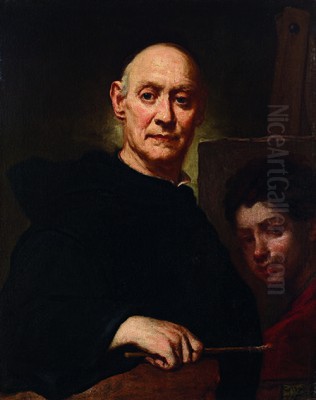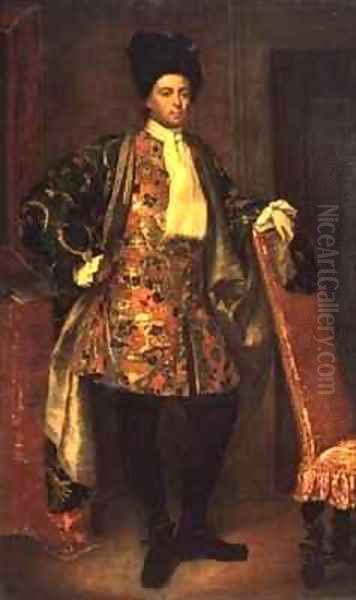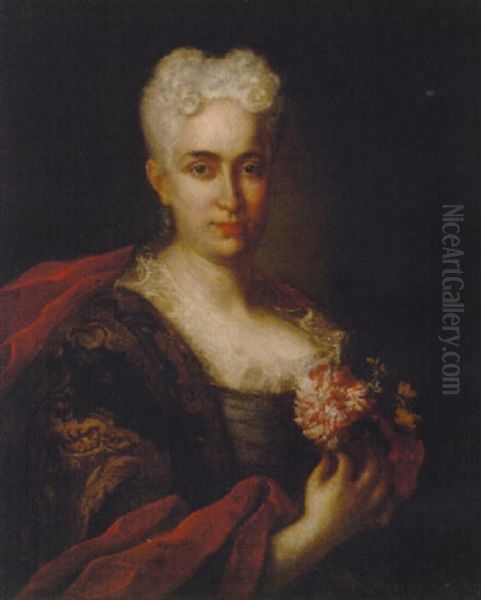
Vittore Giuseppe Ghislandi, more famously known by his religious name Fra' Galgario, stands as one of the most significant portrait painters of the Italian Late Baroque period. Active primarily in Lombardy, particularly his native Bergamo, Ghislandi developed a distinctive style characterized by penetrating realism, sophisticated handling of light and shadow, and a remarkable ability to capture the psychological depth of his sitters. His life, intertwined with religious devotion and artistic dedication, produced a body of work that remains highly esteemed for its technical brilliance and human insight.
Early Life and Artistic Formation
Born in Bergamo on March 4, 1655, Vittore Giuseppe Ghislandi entered a world already steeped in artistic tradition. His father, Domenico Ghislandi, was a painter himself, specializing in perspective and architectural scenes. This familial environment likely provided the young Vittore with his initial exposure to the visual arts and the fundamentals of drawing and painting. Bergamo, a city with a rich artistic heritage, including the legacy of Lorenzo Lotto, offered a stimulating backdrop for his early development.
Seeking broader horizons and more advanced training, Ghislandi traveled to Venice, the vibrant artistic capital of the Veneto region. This move proved pivotal for his career. In Venice, he entered the studio of Sebastiano Bombelli, a highly respected and successful portrait painter. Bombelli, known for his elegant depictions of the Venetian aristocracy, operated in the grand tradition of Venetian portraiture, looking back to masters like Titian and Tintoretto.
Under Bombelli's tutelage, Ghislandi honed his skills, absorbing the lessons of Venetian colorito (emphasis on color and brushwork) and the techniques for rendering rich fabrics and capturing dignified likenesses. He served as Bombelli's student and assistant, immersing himself in the city's artistic milieu. During his Venetian years, he diligently studied the works of the great masters of the Venetian School, particularly the towering figures of Tiziano Vecellio, known as Titian, and Paolo Veronese. Their command of color, composition, and human form left an indelible mark on his developing style.
The Venetian Years and Religious Calling

Ghislandi's time in Venice was not solely dedicated to artistic pursuits. In 1675, he made a significant life choice by joining the Order of the Minims of Saint Francis of Paola, a Catholic religious order known for its austerity and devotion. He took the religious name Fra' Vittore. This decision to enter religious life would shape his identity and public persona for the rest of his career, although it did not curtail his artistic activities.
His association with the Minims provided a framework for his life, but his primary vocation remained painting. He continued to work and refine his craft in Venice for a considerable period, likely balancing his religious duties with his artistic practice. The experience gained in Venice, both technically under Bombelli and through exposure to the city's unparalleled artistic treasures, was fundamental. He learned to combine meticulous observation with a painterly approach, a hallmark that would distinguish his later work.
The influence of Venetian art, particularly its emphasis on capturing the textures of materials and the play of light, remained a constant in his work. While Bombelli's style was perhaps more formal and official, Ghislandi began to develop a more personal and psychologically penetrating approach to portraiture, hinting at the direction his mature style would take.
Return to Bergamo: Fra' Galgario
After an extended period in Venice, spanning roughly two decades, Ghislandi returned to his native Bergamo around 1702. Upon his return, he settled in the Convent of the Galgario, which was associated with his religious order. It was from this point onwards that he became widely known as Fra' Galgario, the name derived from the monastery where he resided.
His return marked the beginning of his most productive and celebrated period as an artist. While living as a lay brother, he established himself as the preeminent portrait painter in Bergamo and the surrounding Lombard region. His studio became a magnet for the local aristocracy, clergy, fellow artists, and members of the rising merchant class, all seeking to have their likeness captured by his skilled hand.
His religious affiliation did not isolate him from the secular world; rather, it seems to have coexisted with a thriving artistic practice. He navigated both spheres, maintaining his monastic ties while engaging actively with patrons and the broader artistic community. The name "Fra' Galgario" became synonymous with high-quality portraiture in Lombardy.
Artistic Style: Realism, Chiaroscuro, and Psychological Depth

Fra' Galgario's mature style is a compelling blend of influences synthesized into a unique artistic voice. The foundations laid in Venice – the rich color, the attention to texture – remained, but were infused with a powerful Lombard realism and a sophisticated use of chiaroscuro. His work is often noted for its striking naturalism, moving beyond mere likeness to capture the personality and inner life of the sitter.
A key characteristic of his style is the masterful handling of light and shadow. Deep shadows often envelop parts of the figure or background, throwing the illuminated features into sharp relief. This technique, reminiscent in its dramatic effect of earlier masters like Caravaggio, though less stark, imbues his portraits with a sense of volume and presence. It also serves to focus the viewer's attention on the face and expression, enhancing the psychological impact.
Ghislandi possessed a remarkable ability to render textures – the sheen of silk, the roughness of wool, the softness of fur, the gleam of metal. His brushwork could be both precise in details and surprisingly bold and free in other areas, contributing to the vitality of the painted surface. He often used a relatively thick application of paint, sometimes approaching impasto, giving his works a tangible quality. Sources mention a technique involving vibrant pigments and underlayers to enhance the chromatic richness, likely referring to his skillful layering and juxtaposition of colors to achieve luminosity and depth.
While influenced by the grandeur of Venetian art (Titian, Veronese) and the official style of his master Bombelli, Ghislandi's work also shows an affinity with Northern European traditions, particularly the realism and psychological insight found in the work of Rembrandt van Rijn. Although direct contact is unproven, Ghislandi may have encountered Rembrandt's influence indirectly, perhaps through prints or through artists familiar with his work, such as Rembrandt's pupil Wilhelm Drost, who is known to have worked in Italy. This Northern influence is seen in the unidealized portrayal of features and the focus on character over flattery.
Subjects and Themes: A Gallery of Lombard Society
Fra' Galgario's oeuvre consists almost exclusively of portraits, offering a fascinating cross-section of Lombard society in the late 17th and early 18th centuries. His sitters ranged from powerful nobles and high-ranking clergy to fellow artists, young apprentices, scholars, and even figures whose status seems more ambiguous, perhaps representing the burgeoning middle class.
He was particularly sought after by the aristocracy of Bergamo, Milan, and the wider Lombard region. His portraits of noblemen and women often convey a sense of dignity and status, yet they rarely succumb to empty pomp. Ghislandi consistently sought the individual behind the rank, capturing subtle expressions and suggesting complex personalities. Works like his Portrait of a Gentleman (sometimes identified as Portrait of a Knight) exemplify this ability to balance social standing with individual characterization.
A notable and recurring theme in his work is the portrayal of young people, especially boys and young men. These portraits are often among his most compelling and enigmatic. He depicted them sometimes in aristocratic attire, sometimes dressed as artists or apprentices, and occasionally in fanciful costumes. These works, such as the celebrated Portrait of a Young Painter or the various depictions titled Portrait of a Young Man (including one specifically noted as Portrait of a Young Man with a Hat), often possess a striking directness and psychological intensity. They seem to capture the fleeting nature of youth, ambition, and perhaps a certain melancholy or introspection, showcasing his deep empathy for his subjects.
His self-portraits are also significant. The famous 1732 self-portrait housed in the Accademia Carrara in Bergamo shows him in old age, paintbrush in hand, gazing frankly at the viewer. It is a powerful statement of artistic identity and a testament to his unflinching realism, even when applied to himself. Other self-portraits exist, depicting him at different stages of his life, offering further insight into the artist's self-perception.
Notable Works and Artistic Legacy
Fra' Galgario's reputation rests on a substantial body of high-quality portraits. Among his most recognized works, several stand out:
Self-Portrait (1732): Housed in the Accademia Carrara, Bergamo, this is perhaps his most famous work, showcasing his late style and self-representation as a working artist.
Portrait of a Young Painter: This work exemplifies his interest in depicting fellow artists or apprentices, capturing a sense of creative intensity and youth.
Portrait of Count Galeazzo Secco Suardo: A fine example of his aristocratic portraiture, combining dignity with psychological insight.
Portrait of a Gentleman (or Knight): Demonstrates his skill in rendering formal attire while maintaining a strong sense of the sitter's presence.
Portrait of a Young Man with a Tricorn Hat: Notable for its direct gaze and the masterful handling of textures and light.
Portraits of the Rota Family: Ghislandi painted several members of this prominent Bergamo family, showcasing his consistent patronage among the local elite.
These works, along with many others held in museums and private collections primarily in Italy (especially Bergamo's Accademia Carrara, Milan's Pinacoteca di Brera, and Florence's Uffizi Gallery) but also internationally, solidify his status. They demonstrate his consistent ability to combine technical mastery with profound human observation.
Influences, Contemporaries, and Artistic Context
Fra' Galgario operated within a rich artistic landscape. His primary influences were Venetian: his teacher Sebastiano Bombelli, and the enduring legacies of Titian and Paolo Veronese. The Lombard tradition of realism, perhaps traceable back to artists like Giovanni Battista Moroni in the 16th century, also played a role. The dramatic lighting suggests an awareness, direct or indirect, of Caravaggio's revolution generations earlier.
His potential connection to the Rembrandt school, possibly via Wilhelm Drost, links him to Northern European currents. In terms of contemporaries, he stands out in Lombardy. While Evaristo Baschenis was a master of still life in Bergamo, Ghislandi dominated portraiture. Perhaps his most significant Lombard contemporary in terms of capturing everyday reality, albeit in genre scenes rather than formal portraits, was Giacomo Ceruti (Pitocchetto), known for his unsentimental depictions of the poor.
In the wider Italian context, his contemporaries included figures like the Genoese portraitist Giovanni Maria delle Piane (Il Mulinaretto), with whom some stylistic affinities can be noted. In Venice, while Ghislandi focused on oil portraits, Rosalba Carriera was achieving international fame with her pastel portraits, and Giambattista Tiepolo was reaching the height of his powers in grand decorative painting. The work of internationally renowned portraitists like the French masters Hyacinthe Rigaud and Nicolas de Largillière, who defined aristocratic portraiture in the age of Louis XIV, provides a broader European context for Ghislandi's achievements, though his style remained distinctly Italian and personal. The influence of earlier masters of aristocratic portraiture like Anthony van Dyck can also be seen as part of the general heritage he drew upon. His own father, Domenico Ghislandi, represents his earliest artistic connection. Later Venetian portraitists like Alessandro Longhi would continue the tradition Ghislandi participated in.
Later Life and Enduring Reputation
Fra' Galgario remained active as a painter into his old age, working primarily from his base in the Galgario monastery in Bergamo. His reputation solidified, and he was widely regarded as the leading portraitist in the region. His works were sought after not only for their accurate likenesses but also for their artistic quality and psychological depth. He continued to receive commissions from prominent families and institutions.
He passed away in Bergamo in December 1743, at the venerable age of 88. He left behind a significant legacy, having created a unique and powerful body of work within the Italian Baroque tradition. His portraits offer invaluable documentation of the society of his time, but more importantly, they stand as compelling works of art in their own right.
Fra' Galgario is considered one of the last great masters of the Italian Baroque, and arguably one of the finest portrait painters Italy produced in the 18th century. His work bridges the gap between the formal grandeur of the High Baroque and the emerging sensibilities of the Rococo and Enlightenment periods, particularly in its emphasis on realism and individual psychology. His influence can be seen in subsequent Lombard painting, and he remains a key figure in the history of Italian portraiture.
Conclusion
Vittore Giuseppe Ghislandi, Fra' Galgario, was more than just a skilled craftsman; he was an artist of profound sensitivity and technical brilliance. Rooted in the traditions of Venetian color and Lombard realism, he forged a distinctive style that captured the essence of his sitters with honesty and insight. From nobles and clergy to artists and young boys, his portraits reveal a deep engagement with the human condition. Living a life balanced between religious devotion and artistic practice, he created a legacy that confirms his place as a master of the Italian Late Baroque and one of the most compelling portraitists of his era. His works continue to engage viewers with their lifelike presence and psychological depth, securing his enduring importance in the annals of art history.